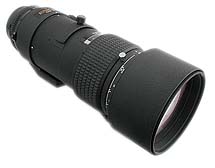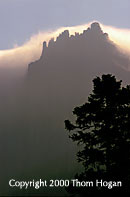Autofocus
Nikkor 300mm f/4 IF-ED |
||||||
| Known as the poor man's tele, the older Nikkor 300mm f/4 produces remarkably good photos.
The BasicsSince it's introduction in 1988, the 300mm f/4 has been the low-cost alternative for a high-quality telephoto lens in Nikon's lineup. This lens has a maximum f/4 aperture, with a minimum aperture of f/32. Minimum focus distance is a modest 8 feet (2.5). A built-in slide-out hood provides excellent shielding for the large 82mm front element. The lens cap is a soft, leather affair that some love, some hate. You can't remove it quite as quickly or without looking like you can the traditional cap, but it does protect the lens quite well. Filters are the special 39mm drop-in variety. You get two drop-in brackets with the lens, and if you're not using filters, the one with the flat glass element in it should always be used (it's part of the optical formula).
The focus ring is wide and easily distinguished. An auto/manual focus switch is built into focus ring, and a user-adjustable focus limiter sits just in front, allowing you to set the range the lens will focus in. A rotatable tripod mount is provided. The lens weighs in at nearly three pounds (47 ounces).
HandlingThe aperture ring has one annoying surprise: when you set f/32, the aperture ring locks at this f/stop. You release the lock by pressing a small button on the right of the ring. Of course, on a camera that requires the minimum aperture be set (the F5, for example), who cares? But if you're using this lens on an F90x/N90s, it will annoy you. Manual focusing is merely okay, and takes a half turn to go from minimum focus distance to infinity. When set to manual focusing, you don't get that silky MF Nikkor feel, but a noisy, semi-smooth touch. At least the ring stays exactly where you leave it in manual focus mode, and you can easily "tweak" the focus with certainty.
PerformanceOkay, let's get the bad news out of the way: the 300mm f/4 is no speed demon on autofocus. My 70-300mm f/4-5.6D is faster, on every one of my bodies. On my N90s, I've seen it hunt for focus, though I've never seen it do that on the F5. I'd say the 300mm f/4 is barely adequate for sports or wildlife assignments, though with the beefy AF motor in the F5, it's a little better. Fortunately, if you're in a situation with some "knowns," you can use the focus limiter to improve autofocus time. The optics can be summed up in a word: great. The lens produces images with contrast punch and edge-to-edge sharpness at all but the widest and smallest apertures. Wide open, the edges are a tad soft, though I doubt most would notice. At minimum aperture, I think I see a bit of softening, probably due to defraction. It's as if you're using a 300mm f/2.8 that's had one f/stop removed (not surprising, since the original f/2.8 and the f/4 both have 8/6 element designs). With the TC-14B converter, the 300mm f/4 produces credible, publishable images, though there is distinct softening at all apertures, especially at the edges. I'd prefer the MF 400mm f/5.6 or even the 80-400mm VR over the 300mm/TC-14B combo, but carrying multiple telephotos around isn't something I often have the luxury of doing.
|
| Quick Evaluation |
*Optically, this lens is near a five-star rating, but slow focus and the 8 foot minimum distance hold it back.
|
| Table of Contents |
| Other Info |
Also consider:
RB writes: You mention that the aperture ring locks at the f/32 position and the lock is released by pressing a small button on the ring. That is true, but what you don't mention is that this button can be locked in the "aperture ring free" position by holding it down and rotating it anti-clockwise through 90 degrees (there's a tiny white dot on the button which shows which position it's in). |


